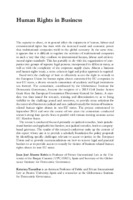Human Rights in Business
Proposal review
Removal of Barriers to Access to Justice in the European Union
Contributor(s)
Álvarez Rubio, Juan José (editor)
Yiannibas, Katerina (editor)
Collection
EU collectionVersion
PublishedLanguage
EnglishAbstract
The capacity to abuse, or in general affect the enjoyment of human, labour and environmental rights has risen with the increased social and economic power
that multinational companies wield in the global economy. At the same time,
it appears that it is difficult to regulate the activities of multinational companies
in such a way that they conform to international human, labour and environmental
rights standards. This has partially to do with the organization of companies
into groups of separate legal persons, incorporated in different states, as
well as with the complexity of the corporate supply chain. Absent a business
and human rights treaty, a more coherent legal and policy approach is required.
Faced with the challenge of how to effectively access the right to remedy in
the European Union for human rights abuses committed by EU companies in
non-EU states, a diverse research consortium of academic and legal institutions
was formed. The consortium, coordinated by the Globernance Institute for
Democratic Governance, became the recipient of a 2013 Civil Justice Action
Grant from the European Commission Directorate General for Justice. A mandate
was thus issued for research, training and dissemination so as to bring
visibility to the challenge posed and moreover, to provide some solutions for
the removal of barriers to judicial and non-judicial remedy for victims of business related
human rights abuses in non-EU states. The project commenced in
September 2014 and over the course of two years the consortium conducted
research along four specific lines in parallel with various training sessions across
EU Member States.
The research conducted focused primarily on judicial remedies, both jurisdictional
barriers and applicable law barriers; non-judicial remedies, both to company based grievance. The results of this research endeavour make up the content of
this report whose aim is to provide a scholarly foundation for policy proposals
by identifying specific challenges relevant to access to justice in the European
Union and to provide recommendations on how to remove legal and practical
barriers so as to provide access to remedy for victims of business-related human
rights abuses in non-EU states.
Keywords
multinationals; european union; human rights; Conflict of laws; Equinor; Member state of the European Union; Permanent Court of Arbitration; Rome II Regulation; Siemens; TortISBN
9781315269467OCN
1000432185Publisher
Taylor & FrancisPublisher website
https://taylorandfrancis.com/Publication date and place
2017Grantor
Imprint
RoutledgeClassification
Law


 Download
Download